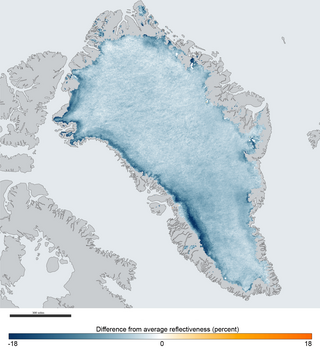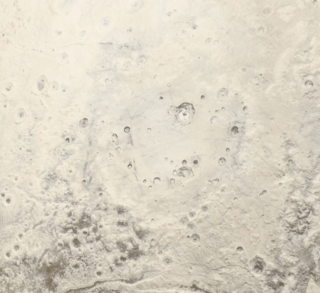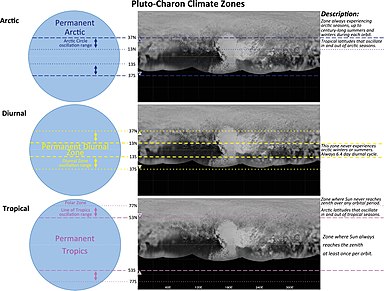
Albedo is the fraction of sunlight that is diffusely reflected by a body. It is measured on a scale from 0 to 1. Surface albedo is defined as the ratio of radiosity Je to the irradiance Ee received by a surface. The proportion reflected is not only determined by properties of the surface itself, but also by the spectral and angular distribution of solar radiation reaching the Earth's surface. These factors vary with atmospheric composition, geographic location, and time.

Pluto is a dwarf planet in the Kuiper belt, a ring of bodies beyond the orbit of Neptune. It is the ninth-largest and tenth-most-massive known object to directly orbit the Sun. It is the largest known trans-Neptunian object by volume, by a small margin, but is less massive than Eris. Like other Kuiper belt objects, Pluto is made primarily of ice and rock and is much smaller than the inner planets. Pluto has roughly one-sixth the mass of Earth's moon, and one-third its volume.

Charon, known as (134340) Pluto I, is the largest of the five known natural satellites of the dwarf planet Pluto. It has a mean radius of 606 km (377 mi). Charon is the sixth-largest known trans-Neptunian object after Pluto, Eris, Haumea, Makemake, and Gonggong. It was discovered in 1978 at the United States Naval Observatory in Washington, D.C., using photographic plates taken at the United States Naval Observatory Flagstaff Station (NOFS).

A cryovolcano is a type of volcano that erupts gases and volatile material such as liquid water, ammonia, and hydrocarbons. The erupted material is collectively referred to as cryolava; it originates from a reservoir of subsurface cryomagma. Cryovolcanic eruptions can take many forms, such as fissure and curtain eruptions, effusive cryolava flows, and large-scale resurfacing, and can vary greatly in output volumes. Immediately after an eruption, cryolava quickly freezes, constructing geological features and altering the surface.

1604 Tombaugh, provisional designation 1931 FH, is a rare-type Eos asteroid from the outer region of the asteroid belt, approximately 32 kilometers in diameter. It was discovered on 24 March 1931, by American astronomer Carl Otto Lampland at Lowell Observatory in Flagstaff, Arizona, in the United States. It was named after the discoverer of Pluto, Clyde Tombaugh.

Dysnomia (formally (136199) Eris I Dysnomia) is the only known moon of the dwarf planet Eris and is the second-largest known moon of a dwarf planet, after Pluto I Charon. It was discovered in September 2005 by Mike Brown and the Laser Guide Star Adaptive Optics (LGSAO) team at the W. M. Keck Observatory. It carried the provisional designation of S/2005 (2003 UB313) 1 until it was officially named Dysnomia (from the Ancient Greek word Δυσνομία meaning anarchy/lawlessness) in September 2006, after the daughter of the Greek goddess Eris.

The dwarf planet Pluto has five natural satellites. In order of distance from Pluto, they are Charon, Styx, Nix, Kerberos, and Hydra. Charon, the largest, is mutually tidally locked with Pluto, and is massive enough that Pluto and Charon are sometimes considered a binary dwarf planet.
The Bond albedo, named after the American astronomer George Phillips Bond (1825–1865), who originally proposed it, is the fraction of power in the total electromagnetic radiation incident on an astronomical body that is scattered back out into space.

A dwarf planet is a small planetary-mass object that is in direct orbit around the Sun, massive enough to be gravitationally rounded, but insufficient to achieve orbital dominance like the eight classical planets of the Solar System. The prototypical dwarf planet is Pluto, which for decades was regarded as a planet before the "dwarf" concept was adopted in 2006.

The Mars general circulation model is the result of a research project by NASA to understand the nature of the general circulation of the atmosphere of Mars, how that circulation is driven and how it affects the climate of Mars in the long term.
1722 Goffin, provisional designation 1938 EG, is a stony asteroid from the central region of the asteroid belt, approximately 10.3 kilometers in diameter.
1522 Kokkola, provisional designation 1938 WO, is a stony Vestian asteroid from the inner regions of the asteroid belt, approximately 9.5 kilometers in diameter. It was discovered on 18 November 1938, by pioneering Finnish astronomer Liisi Oterma at Turku Observatory in Southwest Finland. It was later named for the town of Kokkola.

1389 Onnie, provisional designation 1935 SS1, is a stony Koronian asteroid from the outer region of the asteroid belt, approximately 13 kilometers in diameter. It was discovered on 28 September 1935, by Dutch astronomer Hendrik van Gent at Leiden Southern Station, annex to the Johannesburg Observatory in South Africa.

The atmosphere of Pluto is the layer of gasses that surround the dwarf planet Pluto. It consists mainly of nitrogen (N2), with minor amounts of methane (CH4) and carbon monoxide (CO), all of which are vaporized from surface ices on Pluto's surface. It contains layered haze, probably consisting of heavier compounds which form from these gases due to high-energy radiation. The atmosphere of Pluto is notable for its strong and not completely understood seasonal changes caused by peculiarities of the orbital and axial rotation of Pluto.

Lobate debris aprons (LDAs) are geological features on Mars, first seen by the Viking Orbiters, consisting of piles of rock debris below cliffs. These features have a convex topography and a gentle slope from cliffs or escarpments, which suggest flow away from the steep source cliff. In addition, lobate debris aprons can show surface lineations as do rock glaciers on the Earth.

The geology of Charon encompasses the characteristics of the surface, crust, and interior of Pluto's moon Charon. Like the geology of Pluto, almost nothing was known of Charon's geology until the New Horizons of the Pluto system on 14 July 2015. Charon's diameter is 1,208 km (751 mi)—just over half that of Pluto. Charon is sufficiently massive to have collapsed into a spheroid under its own gravity.

Burney, sometimes referred to as the Burney basin, is a large multi-ringed impact basin on the dwarf planet Pluto. With a diameter of over 290 kilometers, it is the second-largest known impact basin on Pluto, after the Sputnik Planitia basin. Burney is the only impact basin with visible multiple rings known on Pluto, though its rings have been heavily eroded due to Burney's age.
Atmospheric super-rotation is a phenomenon where a planet's atmosphere rotates faster than the planet itself. This behavior is observed in the atmosphere of Venus, atmosphere of Titan, atmosphere of Jupiter, and atmosphere of Saturn. Venus exhibits the most extreme super-rotation, with its atmosphere circling the planet in four Earth days, much faster than its planet's own rotation. The phenomenon of atmospheric super-rotation can influence a planet's climate and atmospheric dynamics.

Caleuche Chasma is a Y-shaped chasma on Pluto's moon, Charon. Caleuche Chasma is 400 km (250 mi) long. The feature was discovered using stereoscopic processing of New Horizons images. At approximately 13 km (8.1 mi) deep, it is the deepest known feature on the natural satellite, and one of the deepest known canyons in the Solar System.

















